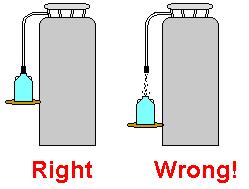| Page 3 |

|
|
1 - Liquid Nitrogen Safety
2 - Page 2 3 - Page 3 4 - Page 4 |

Handling and Storage
Store and use this product with adequate ventilation.
Do not store in a confined space.
Cryogenic containers are equipped with pressure relief devices to control internal pressure. Under normal conditions, these containers will periodically vent product.
Do not plug, remove, or tamper with any pressure relief device.
Never allow any unprotected part of the body to come in contact with uninsulated pipes or equipment that contains cryogenic product. The extremely cold metal will cause the flesh to stick fast and tear when one attempts to withdraw from it.
Use a suitable hand truck for container movement. Containers should be handled and stored in an upright position. Do not drop, tip, or roll containers on their sides. Do not remove or interchange connections.
Contact the vendor if you experience any difficulty operating the container valve or with the container connections. Discontinue use. Use the proper connection. DO NOT USE ADAPTERS!
Use piping and equipment designed to withstand the pressures to be encountered. On gas withdrawal systems, use a check valve or other protective apparatus in any line or piping from the container to prevent reverse flow.
To prevent cryogenic liquids or cold gas from being trapped in piping between valves, the piping should be equipped with pressure relief devices. Only transfer lines designed for use with cryogenic liquids should be used.
Some elastomers and metals such as carbon steel may become brittle at low temperatures and will easily fracture. These materials must be avoided in cryogenic service. It is recommended that all vents be piped to the exterior of the building or to a well ventilated indoor space.
Small quantities of liquid nitrogen can be stored in Dewar bottles. Dewar bottles are hollow-walled glass-lined containers which provide excellent insulation.Dewar bottles will keep liquid nitrogen for a fairly long period of time. If you do not have a dewar, a standard Thermosbottle with a stainless steel shell will work fine for transporting and storing small amounts of liquid nitrogen for a short time. Thermos bottles have screw-on caps.
CAUTION !!! THE CAP MUST NEVER BE SCREWED ON AT ANY TIME LIQUID NITROGEN IS IN THE BOTTLE. If the cap is not vented the liquid nitrogen will boil and build up pressure until the bottle EXPLODES.
Dispensing from large dispensing Dewar
 |
- Nitrogen is to be dispensed only into smaller Dewars which either (a) have carrying handles or (b) are on wheels or (c) are 500 mL or smaller, and which have pressure relief valves or pressure venting lids. A wide-base Dewar which is stable on a wheeled cart qualifies as "on wheels."
- Persons filling must be in constant attendance to the filling operation.
- If the receiving vessel is small enough to be placed on the adjustable table, adjust the table so that the delivery is immediately at the mouth of the receiving vessel. (I.e., do not allow the liquid nitrogen to fall through a distance to reach the receiving vessel.) If the vessel is too large for the table, or the table is missing or inoperable, other provisions must be made for safely raising the vessel up to the delivery tube.
- Do not hold the vessel with unprotected hands while filling.
- Do NOT move/bend the copper fill tube. It causes wear that will eventually cause the tube to break.
- Persons filling Dewars should wear full length non-cuffed trousers (covering tops of shoes) or full length apron, and shoes which will not admit spilled cryogen and which are easy to remove quickly. Also wear goggles and cryo-gloves.
| << Previous 1 2 [3] 4 Next >> |

